Marketing fundamentals are the core principles that drive business growth. They help you attract customers, increase sales, and build lasting relationships.
What are the fundamentals of marketing? The fundamentals of marketing include seven key elements:
- Target audience identification
- Value proposition development
- Digital channel selection
- Performance measurement
- Customer acquisition optimization
- Retention strategies
- Scalable growth systems
What are the fundamentals of digital marketing? Digital marketing fundamentals focus on online channels. These include SEO, email marketing, social media, content creation, and paid advertising. Email marketing delivers $36-40 for every $1 invested. Organic search is preferred by 49% of marketers for the best ROI.
B2B marketing fundamentals differ from consumer marketing. B2B involves longer sales cycles and multiple decision-makers. What are the marketing fundamentals for B2B? It requires relationship-building and educational content approaches.
What Are Marketing Fundamentals?
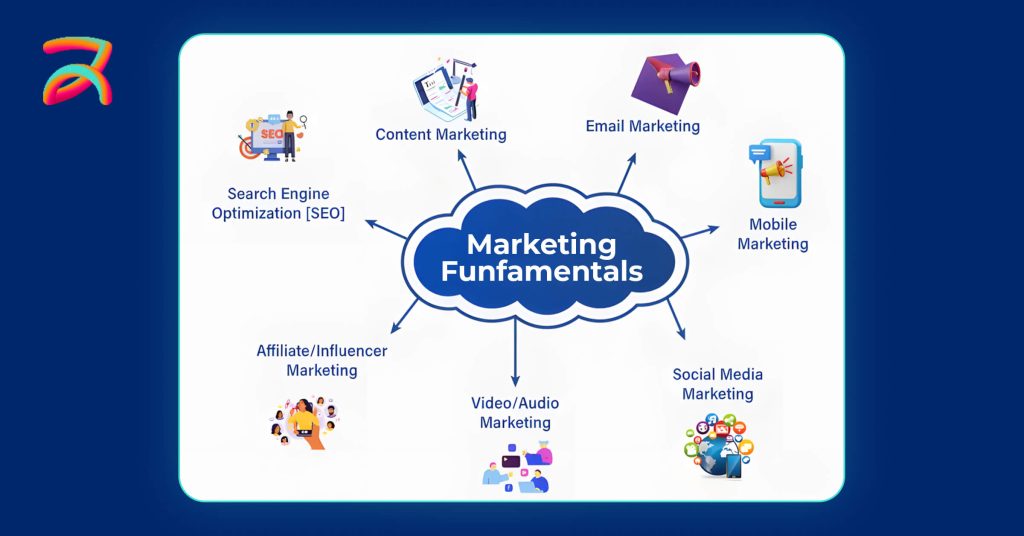
The Complete Definition of Marketing Fundamentals
Marketing fundamentals are the core principles and strategies that businesses use to identify, attract, and retain customers while maximizing return on investment. These include market research, target audience identification, value proposition development, channel selection, and performance measurement.
Think of marketing fundamentals as the foundation of your house. Without a solid foundation, everything else you build on top becomes unstable. The same applies to your business growth strategies.
The beauty of mastering these fundamentals lies in their universal application. Whether you’re selling handmade crafts or B2B software solutions, the core principles remain consistent while the execution adapts to your specific market.
Traditional vs Modern Marketing Fundamentals
The marketing world has transformed dramatically over the past decade. What worked in 2015 might actually hurt your business today. Marketing trends in 2025 show that 82% of consumers prefer buying from brands that share their values, making authenticity more important than ever.
| Traditional Fundamental | Modern Evolution | Small Business Application |
| Mass advertising | Targeted digital ads | Micro-targeting local customers |
| Print collateral | Content marketing | Automated social media posting |
| Cold calling | Email nurturing | Automated follow-up sequences |
| Word of mouth | Online reviews | Review management systems |
The shift isn’t just about moving from offline to online. It’s about moving from guesswork to data-driven decisions. Modern marketing fundamentals give you the power to know exactly which efforts drive results and which ones drain your budget.
The 7 Updated Marketing Fundamentals for 2025
Let’s focus on what matters in business right now. These digital marketing fundamentals are based on the latest data from over 1,700 global marketers:
1. Data-Driven Customer Understanding Gone are the days of assuming who your customers are. Today’s successful small businesses use website analytics, social media insights, and customer feedback to build detailed pictures of their ideal buyers.
2. Value Proposition Development: Your value proposition isn’t what you think makes you special; it’s what your customers think makes you special. The difference is crucial.
3. Omnichannel Presence: Your customers don’t live in just one place online. They move between social media, email, search engines, and review sites. Your marketing needs to meet them wherever they are.
4. Automated Customer Journey: Smart small businesses set up systems that nurture leads automatically. This means potential customers get the right message at the right time without you manually sending each email.
5. Real-Time Performance Analytics: You should know within 24 hours whether a marketing campaign is working or failing. Real-time data helps you double down on what works and quickly stop what doesn’t.
6. Community-Centered Engagement: Building a community around your brand creates customers who sell for you. These people become your unpaid marketing team.
7. Sustainable Growth Systems: The best marketing systems work even when you’re not actively managing them. They bring in new customers while keeping existing ones happy.
Digital Marketing Fundamentals: The Complete Small Business Framework
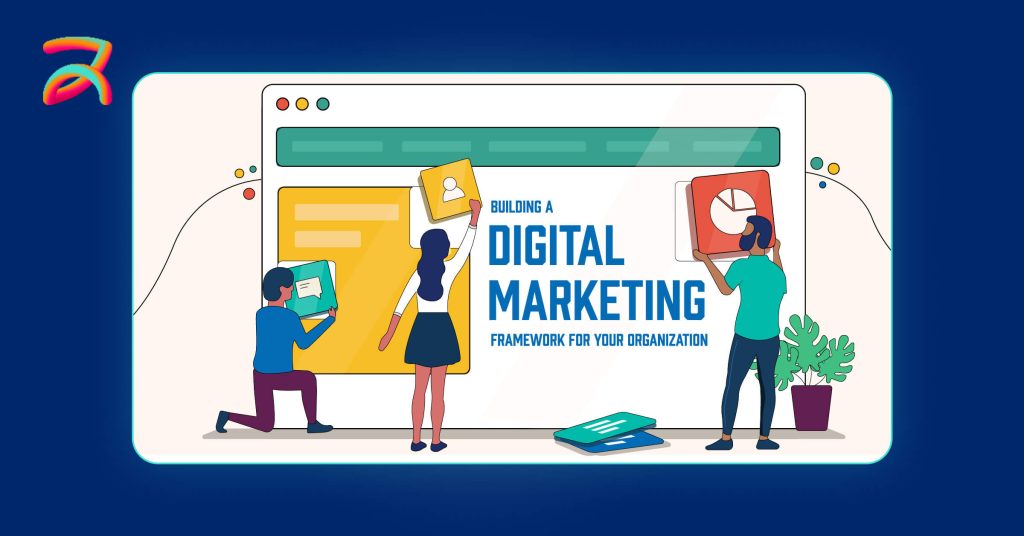
Essential Digital Marketing Channels
Not all digital marketing channels deserve equal attention. Here’s how to prioritize your efforts based on proven return on investment:
High Priority Channels (Start Here):
- Email Marketing: Returns $36-40 for every $1 spent (based on 2025 data)
- Search Engine Optimization: Long-term visibility with compound returns – 49% of marketers report organic search delivers the best ROI
- Social Media Marketing: Direct connection with your audience – Instagram leads social platforms with the highest ROI, according to 33% of marketers
When implementing social media services for your business, focus on platforms where your audience spends time. Many businesses partner with specialized agencies like Buzzz to manage their social media presence effectively while they focus on core operations.
Medium Priority Channels (Add When Ready):
- Pay-Per-Click Advertising: Immediate results but requires a budget – Google Ads delivers $8 return for every $1 spent
- Content Marketing: Builds authority over time – short-form video content leads with 21% of marketers reporting the highest ROI
- Local SEO: Critical for location-based businesses
Experimental Channels (Test Later):
- Influencer Partnerships: High potential but unpredictable results
- Podcast Advertising: Growing rapidly but niche-dependent
- Video Marketing: Time-intensive but highly engaging
The key is starting with one channel and mastering it before moving to the next. Too many business owners spread themselves thin across multiple channels and see mediocre results everywhere instead of excellent results somewhere.
Digital Marketing vs Traditional Marketing: 2025 Comparison
Understanding the fundamental differences helps you allocate resources more effectively. Current data shows that digital advertisements can increase brand awareness by 80%, making the digital approach increasingly valuable:
| Aspect | Traditional Marketing | Digital Marketing |
| Targeting Precision | Broad demographics | Behavioral targeting |
| Cost Efficiency | High upfront costs | Scalable budgets |
| Measurement Capability | Limited attribution | Multi-touch tracking |
| Response Time | Days to weeks | Real-time |
| Personalization Level | One-size-fits-all | Individual customization |
Traditional marketing still has its place, especially for local businesses. But digital marketing fundamentals give you superpowers that weren’t available to previous generations of entrepreneurs.
The biggest advantage? You can start with $100 and compete with companies spending $100,000. You just need to be smarter about where you spend that money.
🚀 Curious About Digital vs Traditional Marketing?
Discover which approach drives the best results for your business. Connect with Buzzz experts for a strategy that maximizes ROI and engages your audience effectively.
Let’s Get Started! →B2B Marketing Fundamentals: Advanced Strategies for Business Growth

B2B vs B2C Marketing: Core Differences Explained
If you’re selling to other businesses, the fundamentals of marketing shift significantly. Here’s what changes:
B2B Marketing Characteristics:
- Decision Making: Committee-based (3-7 stakeholders)
- Sales Cycle: Extended (6-18 months average)
- Purchase Value: High-ticket ($10,000-$1,000,000+)
- Content Focus: Educational, technical, ROI-focused
- Relationship Building: Long-term partnerships
B2C Marketing Characteristics:
- Decision Making: Individual or household
- Sales Cycle: Short (minutes to days)
- Purchase Value: Lower-ticket ($10-$1,000)
- Content Focus: Emotional, lifestyle-driven
- Relationship Building: Transactional to loyalty
The B2B marketing fundamentals require more patience but typically deliver higher lifetime customer value. A single B2B client might be worth 100 or 1,000 B2C customers.
B2B Sales Funnel Optimization
The fundamentals of marketing in B2B environments require a more sophisticated approach. Here’s how successful companies structure their customer journey:
Stage 1: Awareness: Your potential customers recognize they have a problem, but don’t know solutions exist yet. Your job is to provide educational content that helps them understand their situation better. This might include comprehensive guides similar to our previous analysis of effective Facebook Reels strategies that demonstrated how visual content drives awareness.
Stage 2: Consideration: Now they’re researching solutions and comparing vendors. This is where case studies, product demos, and ROI calculators become powerful tools. Many businesses find success using targeted meta ads agency services to reach decision-makers during this crucial evaluation phase.
Stage 3: Decision: They’re ready to choose a vendor. Personalized presentations, pilot programs, and reference calls help tip the scales in your favor. The Google Ads management guide principles apply here – precise targeting and compelling messaging matter most.
Stage 4: Retention: (Often Overlooked) Keeping existing customers happy costs 5-25 times less than acquiring new ones. Plus, satisfied customers become your best salespeople.
15 Proven Growth Strategies: Marketing Fundamentals in Action
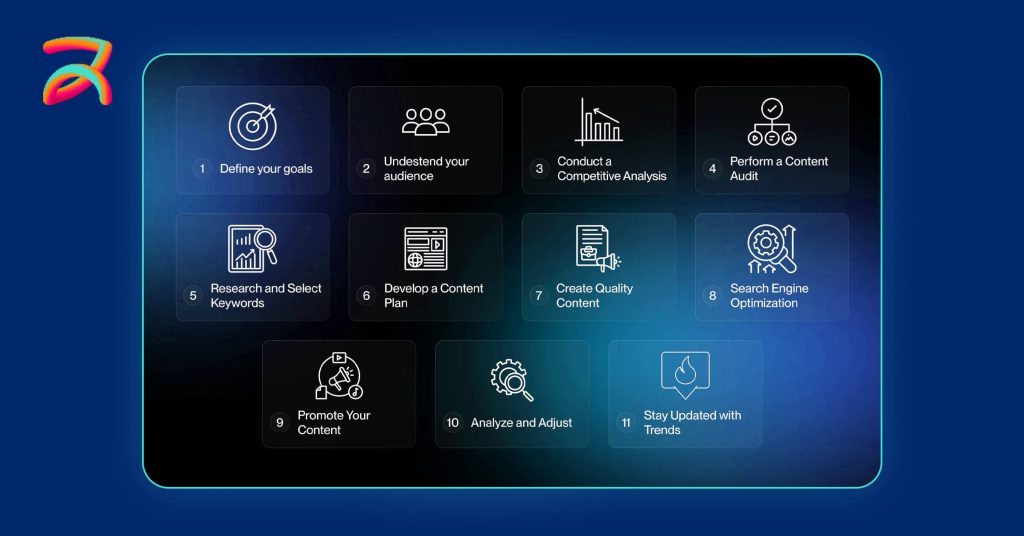
Strategy 1: Customer Segmentation That Actually Works
Most businesses segment customers based on demographics. Smart businesses segment based on behavior and needs.
Start by tracking these data points:
- How customers found you
- Which products do they buy first
- How often do they purchase
- What content do they engage with
- Which communication channels do they prefer
Then create segments based on patterns you discover. You might find that customers who find you through a Google search have different needs than those who come from social media referrals.
Expected Results: 25-40% increase in conversion rates, 30% reduction in customer acquisition cost. These improvements come from understanding what are the fundamentals of digital marketing at a granular level.
Strategy 2: Value Proposition Development Process
Your value proposition should answer three questions:
- What specific problem do you solve?
- How do you solve it differently from competitors?
- What measurable benefits do customers receive?
Step-by-Step Process:
- Interview 10 recent customers about why they chose you
- Analyze competitor messaging to find gaps
- Test different value propositions in your marketing
- Measure which version drives more conversions
- Refine based on data, not opinions
Strategy 3: Email Marketing Automation Setup
Email marketing fundamentals haven’t changed much, but the tools have become incredibly powerful.
Essential Email Sequences:
- Welcome Series: Introduces new subscribers to your business
- Nurture Sequence: Provides value while building trust
- Abandoned Cart: Recovers lost sales from your website
- Re-engagement: Wins back inactive subscribers
- Customer Onboarding: Helps new customers succeed
Set up one sequence per month. Start with the welcome series since every new subscriber will go through it.
Strategy 4: Content Marketing That Drives Sales
Content marketing works, but only if you create content your ideal customers want to consume.
The 70-20-10 Rule:
- 70% of content answers common customer questions
- 20% of content shares industry insights and trends
- 10% of content directly promotes your products/services
This ratio ensures you provide value while still driving business results.
Strategy 5: Local SEO for Small Businesses
If you serve customers in specific geographic areas, understanding Google local service ads cost should be a top priority alongside your local SEO efforts.
Local SEO Checklist:
- Claim and optimize your Google My Business profile
- Get reviews from satisfied customers (aim for 50+ total)
- Include your city/region in website title tags and content
- Build citations on local business directories
- Create location-specific landing pages if you serve multiple areas
Local SEO often delivers faster results than general SEO because you’re competing in a smaller pool.
Strategy 6: Social Media Strategy That Works
Social Media Strategy fundamentals are simple: be helpful, be consistent, be human.
Platform Selection Guide:
- Facebook: Best for community building and local businesses
- Instagram: Perfect for visual products and younger demographics
- LinkedIn: Essential for B2B companies and professional services
- TikTok: Growing rapidly, great for reaching younger audiences
- YouTube: Excellent for educational content and tutorials
Choose 1-2 platforms and do them well rather than spreading yourself across everything.
Strategy 7: Customer Retention Systems
Acquiring new customers gets all the attention, but retaining existing ones drives more profit.
Retention Tactics That Work:
- Regular check-ins with customers
- Loyalty programs with real value
- Exclusive content or offers for existing customers
- Quick response to complaints or issues
- Surprise and delight moments
A 5% increase in customer retention can increase profits by 25-95%.
Strategy 8: Performance Measurement Framework
You can’t improve what you don’t measure. But measuring everything leads to analysis paralysis.
Essential Metrics for Small Businesses:
- Customer Acquisition Cost (CAC): How much you spend to get each new customer
- Customer Lifetime Value (CLV): How much profit each customer generates over time
- CLV:CAC Ratio: Should be at least 3:1, ideally 5:1 or higher
- Conversion Rate: Percentage of visitors who become customers
- Monthly Recurring Revenue: Predictable income from ongoing customers
Track these monthly, and you’ll make better marketing decisions.
Strategy 9: Social Media Community Building
Building an engaged community around your brand creates customers who actively promote your business. Community-driven brands see 5.4 times more growth than those without strong communities.
Implementation Steps:
- Choose one primary platform for community building
- Create valuable, shareable content consistently
- Respond to comments and messages within 2 hours
- Host live sessions or Q&A events monthly
- Encourage user-generated content with branded hashtags
- Collaborate with community members on content
Expected Results: 40-60% increase in customer retention and 25% more referrals within 6 months.
Strategy 10: Referral Program Development
Referred customers have a 37% higher retention rate and spend 200% more than regular customers.
Program Structure:
- Offer meaningful rewards to both referrer and referee
- Make the referral process simple (one-click sharing)
- Track referrals automatically through your system
- Follow up with thank-you messages
- Highlight successful referrals in your marketing
Expected Results: 15-25% of new customers from referrals within 6 months.
Strategy 11: Marketing Automation Workflows
Businesses using marketing automation see a 451% increase in qualified leads and a 12% reduction in marketing overhead.
Essential Workflows:
- Welcome series for new subscribers
- Abandoned cart recovery sequences
- Post-purchase follow-up campaigns
- Re-engagement campaigns for inactive customers
- Birthday and anniversary campaigns
Expected Results: 20-30% increase in customer lifetime value.
Strategy 12: Competitive Analysis Framework
Understanding your competition helps identify market gaps and opportunities.
Analysis Process:
- Identify your top 5 direct competitors
- Analyze their pricing, messaging, and positioning
- Study their social media and content strategies
- Monitor their advertising campaigns
- Find gaps in their service offerings
Expected Results: 10-20% improvement in market positioning and messaging effectiveness.
Strategy 13: Customer Feedback Integration
Companies that actively use customer feedback grow 2.3 times faster than those that don’t.
Feedback Collection Methods:
- Post-purchase surveys
- Regular customer check-ins
- Social media monitoring
- Review platform monitoring
- Exit interviews with churned customers
Expected Results: 25-40% improvement in customer satisfaction scores.
Strategy 14: Multi-Channel Attribution Tracking
Understanding which channels contribute to conversions helps optimize budget allocation.
Tracking Implementation:
- Set up Google Analytics 4 with enhanced e-commerce
- Use UTM parameters for all campaign links
- Implement customer journey mapping
- Track offline conversions back to digital channels
- Regular attribution model analysis
Expected Results: 15-25% improvement in marketing ROI through better budget allocation.
Strategy 15: Seasonal Marketing Campaigns
Seasonal campaigns can boost sales by 30-50% during peak periods when executed properly.
Campaign Planning:
- Identify your industry’s seasonal trends
- Plan campaigns 2-3 months in advance
- Create season-specific content and offers
- Adjust inventory and staffing accordingly
- Analyze performance for next year’s planning
Expected Results: 30-50% revenue increase during peak seasons, 10-15% annual revenue growth.
📞 Ready to Take Your Marketing to the Next Level?
Let’s talk about your goals and map out a strategy that gets results. Our team’s here to help you turn ideas into measurable growth.
Book Your Free Strategy Call →Essential Marketing Technology Stack for Small Businesses
Free Tools Foundation (Budget: $0/month)
Start with free tools and upgrade only when you hit their limitations:
| Function | Free Tool | When to Upgrade |
| Analytics | Google Analytics 4 | 100,000+ monthly visitors |
| Email Marketing | Mailchimp (free tier) | 2,000+ contacts |
| Social Media | Creator Studio | 10+ posts per week |
| SEO | Google Search Console | Need competitive analysis |
| Design | Canva (free) | Need brand consistency |
These free tools can power a business generating six figures in revenue.
Paid Tools Investment Strategy ($100-500/month)
Upgrade in this order based on your business needs:
Priority 1: Email Marketing Platform ($29-99/month) Once you have 2,000+ email subscribers, upgrade to GetResponse, ConvertKit, or ActiveCampaign for better automation features.
Priority 2: Social Media Management ($50-199/month)
Tools like Hootsuite or Buffer save hours and provide better analytics.
Priority 3: SEO Analysis ($99-299/month) SEMrush or Ahrefs helps you understand what’s working and find new opportunities.
Priority 4: Customer Relationship Management ($25-100/month). HubSpot or Pipedrive helps you track leads and manage customer relationships better.
Priority 5: Marketing Automation ($50-500/month). Advanced platforms like ActiveCampaign or HubSpot connect all your marketing efforts.
Marketing Performance Measurement: Advanced Analytics Framework
Essential KPIs for Small Business Marketing
Here are realistic benchmarks based on the latest industry data. Understanding these fundamentals of marketing metrics helps you gauge performance accurately:
| Metric | Excellent | Good | Average | Needs Work |
| Customer Acquisition Cost | Under $50 | $50-100 | $100-200 | Over $200 |
| Customer Lifetime Value | Over $1,000 | $500-1,000 | $200-500 | Under $200 |
| CLV:CAC Ratio | Over 6:1 | 4:1 to 6:1 | 2:1 to 4:1 | Under 2:1 |
| Email Open Rate | Over 25% | 20-25% | 15-20% | Under 15% |
| Website Conversion Rate | Over 5% | 3-5% | 1-3% | Under 1% |
| Social Media Engagement | Over 6% | 3-6% | 1-3% | Under 1% |
Don’t expect to hit “excellent” marks immediately. Focus on consistent improvement over time.
Attribution Modeling for Small Businesses
Most small businesses give all credit to the last touchpoint before a sale. This approach misses the bigger picture.
Better Attribution Methods:
- First-Touch Attribution: Credit the channel that first introduced the customer
- Linear Attribution: Split credit equally among all touchpoints
- Time-Decay Attribution: Give more credit to recent interactions
- Position-Based Attribution: Emphasize first and last interactions
Start with linear attribution to understand the full customer journey.
The Future of Small Business Marketing: 2025-2027 Trends

Trends Worth Your Attention
Video-First Content: Text-based content remains effective, but video consistently generates more engagement across all platforms. Based on 2025 data, 21% of marketers report that short-form videos deliver the highest ROI. You don’t need expensive equipment; phone videos often perform better than polished productions.
Voice Search Optimization: People increasingly use voice assistants to find local businesses. Current statistics show that over 55% of internet traffic comes from smartphones, making voice search optimization crucial for the fundamentals of digital marketing.
Personalization at Scale: Technology now allows small businesses to personalize marketing messages for individual customers without manual work. This represents a fundamental shift in how what are the fundamentals of marketing are applied in practice.
Community Building: Customers want to feel connected to brands and other customers. Building a community around your business creates powerful word-of-mouth marketing. Brands like Buzzz have successfully demonstrated this by creating engaged communities around their social media services.
Trends to Ignore (For Now)
Virtual Reality Marketing: Still too early for most small businesses. The technology and adoption rates haven’t reached practical levels yet.
Blockchain-Based Marketing: Interesting concept, but no proven ROI for small businesses currently.
Advanced AI Tools: Many promise revolutionary results, but often just automate basic tasks you should understand manually first.
Focus on mastering the fundamentals before chasing shiny new trends.
Common Marketing Mistakes Small Businesses Make
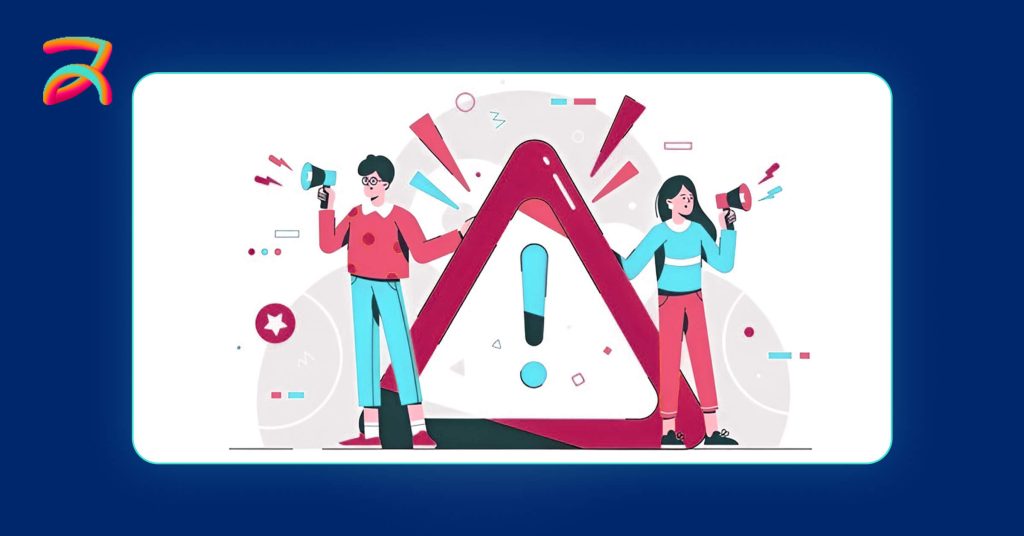
Mistake 1: Trying to Be Everything to Everyone
The Problem: Many small businesses fear turning anyone away, so they create generic marketing that appeals to no one specifically.
The Solution: Choose a specific target audience and create marketing that speaks directly to their needs, problems, and desires.
Mistake 2: Inconsistent Brand Messaging
The Problem: Your website says one thing, your social media says another, and your sales materials say something else entirely.
The Solution: Document your key messages, value proposition, and brand personality. Use these consistently across all marketing materials.
Mistake 3: Focusing Only on New Customer Acquisition
The Problem: Constantly chasing new customers while existing customers feel neglected and eventually leave.
The Solution: Allocate at least 30% of your marketing effort to customer retention and loyalty programs.
Mistake 4: Not Tracking Return on Investment
The Problem: Spending money on marketing activities without knowing which ones actually generate profitable customers.
The Solution: Set up tracking for every marketing channel and measure cost per acquisition and lifetime value.
Mistake 5: Giving Up Too Soon
The Problem: Expecting immediate results from marketing efforts and abandoning strategies before they have time to work.
The Solution: Give most marketing strategies at least 3-6 months to show meaningful results.
Marketing Budget Planning for Small Businesses
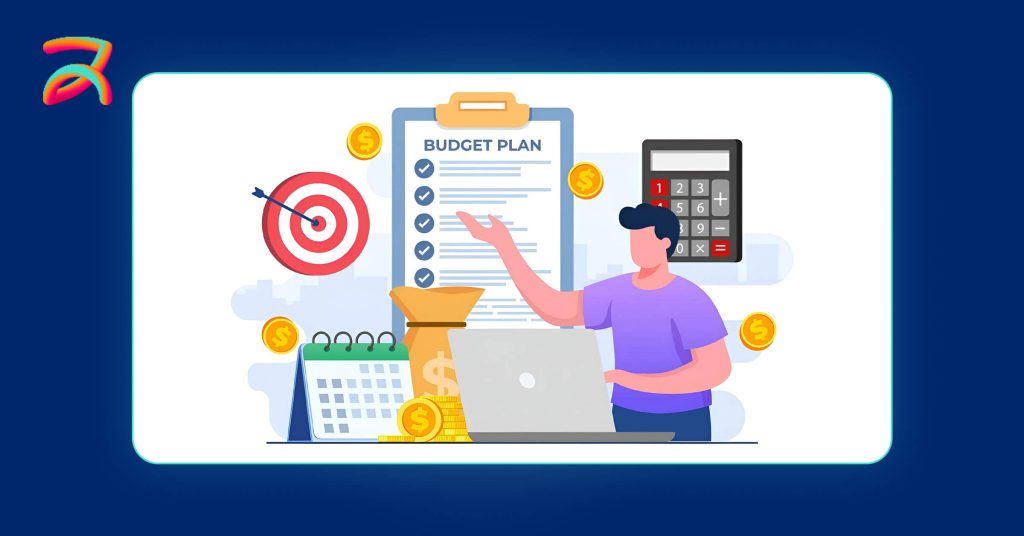
How Much Should You Spend on Marketing?
The standard recommendation is 7-12% of gross revenue for established businesses. New businesses often need to invest 15-20% initially to build market awareness.
Sample Budget Breakdown (Based on $10,000 monthly revenue):
- Total Marketing Budget: $700-1,200 per month
- Digital Advertising: 30% ($210-360)
- Content Creation: 25% ($175-300)
- Email Marketing Tools: 15% ($105-180)
- SEO Tools/Services: 20% ($140-240)
- Social Media Management: 10% ($70-120)
Adjust percentages based on what works best for your specific business and industry.
Free and Low-Cost Marketing Strategies
You don’t need a massive budget to get started. Here are proven strategies that cost more time than money:
Content Marketing: Create blog posts, videos, or podcasts that answer common customer questions. This builds trust and improves search engine rankings.
Email Marketing: Start building an email list from day one. Email consistently delivers the highest ROI of any digital marketing channel.
Social Media Engagement: Focus on being genuinely helpful in social media groups where your ideal customers spend time.
Customer Referral Program: Happy customers are your best marketers. Create a system that makes it easy for them to refer others.
Local Partnerships: Partner with complementary businesses to cross-promote each other’s services.
Frequently Asked Questions About Marketing Fundamentals
The seven fundamentals of marketing for 2025 include: 1) Data-driven customer understanding, 2) Value proposition development, 3) Omnichannel presence, 4) Automated customer journey, 5) Real-time performance analytics, 6) Community-centered engagement, and 7) Sustainable growth systems. These digital marketing fundamentals form the foundation of successful business growth strategies.
Small businesses should allocate 7-12% of gross revenue to marketing, with 60-80% focused on digital channels. New businesses may invest 15-20% initially for market establishment.
Email marketing consistently delivers the highest ROI at $36-40 per $1 invested (based on 2025 data), followed by organic search (49% of marketers report best ROI), social media advertising, and content marketing. Understanding these fundamentals of digital marketing helps prioritize your marketing budget effectively.
B2B marketing fundamentals involve longer sales cycles (6-18 months vs. minutes-days), multiple decision-makers (3-7 stakeholders vs. an individual), higher transaction values, and educational content focus vs. emotional appeal. What is marketing fundamentals in B2B contexts require relationship-building approaches and detailed nurturing processes that differ significantly from consumer-focused strategies.
Essential metrics include Customer Acquisition Cost (CAC), Customer Lifetime Value (CLV), CLV:CAC ratio (target 3:1 minimum), conversion rates, email engagement rates, and return on ad spend (ROAS).
Email marketing and paid advertising can show results within weeks. SEO and content marketing typically take 3-6 months. Brand awareness and customer loyalty building can take 6-12 months or longer.
Marketing fundamentals are the core principles that remain consistent across industries and periods. Advanced strategies are specific tactics that build upon these fundamentals and may vary based on industry, audience, or market conditions.
Start by learning the fundamentals yourself so you can make informed decisions. Consider hiring specialists for specific areas (like SEO or paid advertising) once you understand the basics and have consistent revenue.
Getting Started: Your 30-Day Marketing Fundamentals Action Plan
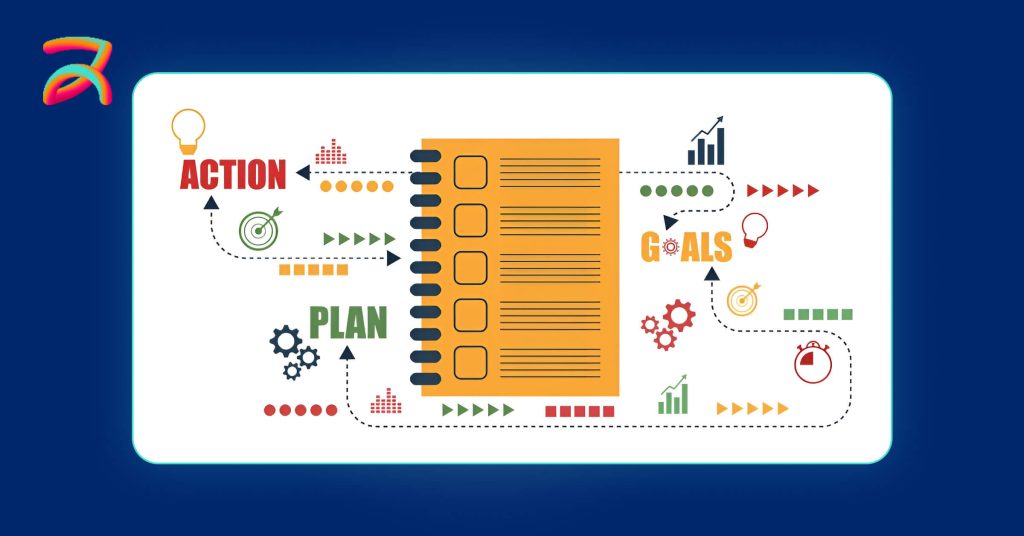
Week 1: Foundation Building
- Define your target audience using the customer segmentation process
- Develop a clear value proposition using customer interviews
- Set up Google Analytics and Google My Business
- Create profiles on 1-2 social media platforms
Week 2: Content and Email Setup
- Start building an email list with a simple lead magnet
- Create a content calendar for the next month
- Write your first blog post or create your first video
- Set up a welcome email sequence
Week 3: Optimization and Measurement
- Install tracking codes on your website
- Create a simple customer survey
- Optimize your website for mobile devices
- Set up social media posting schedule
Week 4: Analysis and Planning
- Review your first month’s data
- Identify what’s working and what isn’t
- Plan your strategy for the next 90 days
- Consider which tools or services to invest in next
📞 Let’s Map Out Your 30-Day Marketing Plan Together
Book your call today and leave with a simple, step-by-step plan you can start using to grow your business this month.
Book Your Free Strategy Call →Remember, the fundamentals of marketing are called fundamentals because they work consistently over time. Master these digital marketing fundamentals before chasing the latest trends, and you’ll build a marketing system that grows your business sustainably for years to come.
The key is starting with one strategy, implementing it well, measuring the results, and then expanding to additional tactics. Small businesses that focus on what are the fundamentals of marketing consistently outperform those chasing every new marketing trend.
Your marketing doesn’t have to be perfect from day one. It just needs to be better than it was yesterday.




